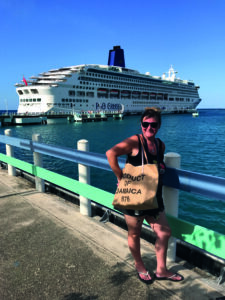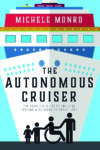
Accessible cruise travel: Michele Monro, author and cruise expert, shares her tips on cruising without boundaries
 I have been cruising for more than 40 years. But when I was diagnosed with multiple sclerosis around 25 years ago, I began to notice the lack of information for people with limited mobility; places I had visited previously suddenly had obstacles I hadn’t encountered before.
I have been cruising for more than 40 years. But when I was diagnosed with multiple sclerosis around 25 years ago, I began to notice the lack of information for people with limited mobility; places I had visited previously suddenly had obstacles I hadn’t encountered before.
Different health conditions make various aspects of holidaying challenging. When it comes to cruise trips, understand your abilities and limitations so you can choose an itinerary – and ship – that is realistic. Work out any additional needs in advance.
Which ship?
When planning a cruise, the most important consideration is ship choice, especially for wheelchair users. The general rule is that newer ships have better facilities. Most larger companies are frontrunners when it comes to onboard facilities for travellers with extra needs and have trained staff for guests with physical challenges. Larger ships tend to have wider gangways and some have a rollator that enables easy access.
Which cabin?
Choosing the right cabin is imperative, preferably one with electronic doors, 360-degree turning angles, ramped access to the bathroom, roll-in showers and low hanging space.
Health and safely restrictions mean that chairs are not allowed to be left in the corridors. If you haven’t booked an accessible cabin for your equipment, it will be refused on embarkation. If you book a balcony, ensure it is large enough for you and your mobility aid as some have space for two chairs and little else.
When booking an accessible cabin, you may be asked if you will accept a free upgrade if one becomes available. Do NOT accept as you might then be allocated a non-accessible cabin.
On board
Some cruise ships have automatic deck doors, accessible restrooms, designated theatre and restaurant seating and lower gaming tables in the casino. Quite a few ships incorporate swimming pool and whirlpool hoists but for use at particular times.
All modern cruise ships provide a medical centre on board, staffed with at least one doctor and two nurses. The ship’s doctor can engage with local port health authorities or your specialist if the need arises.
Get kitted out
Once you are ready to book, contact the cruise line’s accessibility department for requests, pier assistance and excursions advice.
You don’t have to lug all your accessibility equipment with you. Mobility at Sea, a worldwide mobility rental devices company, will make sure your bed hoist, shower stool, raised toilet seat, powerchair, scooter or walker is waiting in your cabin for your arrival.
Declare equipment before embarkation, or it may be refused. Most terminals supply wheelchair assistance at the embarkation port. Take out equipment insurance, as a replacement or repair could be costly.
Even if you don’t use a wheelchair at home, consider renting one at sea if you have limited mobility as it’s easy to underestimate just how many miles you can walk on the ship in a single day. Some ports have extremely long piers or ship-to-shore walkways. A powerchair gives you the freedom to get off without worrying whether you can cope with the distance.
Make sure your electrical mobility aids are compatible with the voltage on the ship and that you pack a two- or four-point extension lead as most cabins only have one plug socket. Carry an emergency repair kit. Spare inner tubes, tyre repair patches, a Phillips screwdriver, hex wrench, or air pump could come in handy.
For those on regular medication, pack ample supplies as the ship might not be able to meet your prescription needs should you run out, and some medications can be impossible to find in port. Carry a copy of your medical history, insurance information and your rheumatologist’s contact details.
Land ahoy!
Select your destinations carefully and avoid tender ports whenever possible as most would-be passengers don’t realise that if you are a permanent wheelchair user you cannot get off the ship if you have to tender ashore. (Tending is used when the ship anchors at sea and small boats ferry passengers across.)
There are a few exceptions where state of the art new builds have equipment that enables wheelchair users to use the tender. Take note that most cruise lines have a weight restriction on chairs that want to use the tender service.
Cruise lines provide accessible tours at selected ports wherever possible. When purchasing, ask staff to make sure the tour is suitable for you. Read the description of each tour and the small print as there may be discrepancies. For example, one cruise line’s website boasts a selection of wheelchair-accessible tours, but on further investigation it transpires that very few are step-free.
Living with a disability presents several obstacles, but a cruise holiday doesn’t have to be one of them. Happy cruising.
 The Autonomous Cruiser: The Complete Guide To Cruising For and With Disabled Travellers by Michele Monro (published by Clink Street Publishing) is about £25 from booksellers and www.amazon.co.uk.
The Autonomous Cruiser: The Complete Guide To Cruising For and With Disabled Travellers by Michele Monro (published by Clink Street Publishing) is about £25 from booksellers and www.amazon.co.uk.
